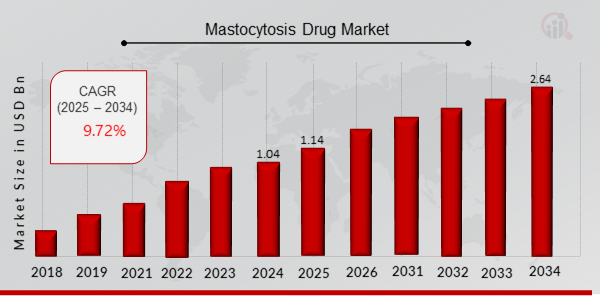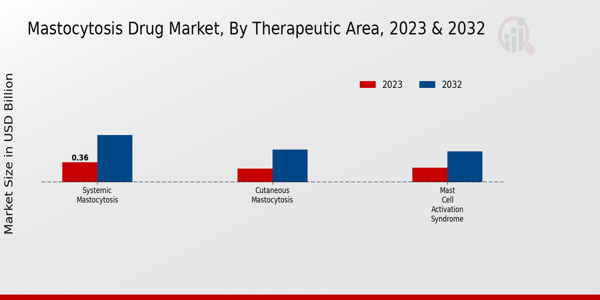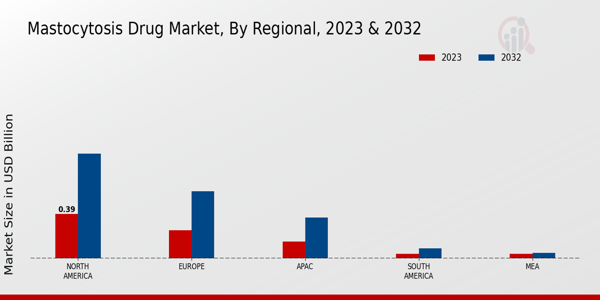Mastocytosis Drug Market Overview
As per MRFR analysis, the Mastocytosis Drug Market Size was estimated at 1.04 (USD Billion) in 2024. The Mastocytosis Drug Market Industry is expected to grow from 1.14 (USD Billion) in 2025 to 2.64 (USD Billion) till 2034, at a CAGR (growth rate) is expected to be around 9.72% during the forecast period (2025 - 2034).

Source Primary Research, Secondary Research, MRFR Database and Analyst Review
Key Mastocytosis Drug Market Trends Highlighted
The Global Mastocytosis Drug Market is expanding rapidly, supported by the increasing prevalence of mastocytosis and a greater understanding of what such a condition entails for patients. The rising incidence of this rare disease is prompting healthcare experts to define its intricacies in more precise terms, enhancing its diagnosis and treatment. In addition, R&D activities also help produce advanced and novel therapies for patients. The trend for personalized medicines is one of the key factors of market growth, bringing new opportunities for patients with mastocytosis with various clinical findings. Prospects in the mastocytosis drug market seem attractive with the advent of new treatment measures being developed.
Pharmaceutical companies are looking into the use of biologics and targeted therapies that have the potential to improve treatment outcomes while reducing adverse effects. The increasing focus on genetic and molecular mechanisms of mastocytosis is likely to provide avenues for groundbreaking clinical trials. With other players focusing on research, there is the opportunity to come up with new drugs that are likely to change treatment approaches, and a large number of patients are likely to benefit. In recent times, there has been a shift from traditional treatment approaches to more integrated ones in the management of mastocytosis. There is some evidence of increased connections between research institutions, pharmaceutical firms, and organizations supportive of patients to facilitate knowledge and resources of varying natures to be used efficiently.
Also sneaking into the limelight are the digital health apps that enable patients to self-manage their conditions and to communicate in a timely manner with the service providers. Ultimately, the Global Mastocytosis Drug Market is altering rapidly, with a multi-pronged approach being pursued toward enhancing the lives of those suffering from this intricate disorder.
Mastocytosis Drug Market Drivers
Increasing Prevalence of Mastocytosis
The rising incidence of mastocytosis globally is one of the most significant drivers for the growth of the Global Mastocytosis Drug Market Industry. The condition, characterized by an abnormal proliferation of mast cells, has gained more recognition in recent years due to better diagnostic methods and increased awareness among healthcare professionals. With advances in molecular and genetic testing, early detection of mastocytosis has become more feasible, leading to a higher number of diagnosed cases.As the understanding of mastocytosis continues to evolve, more patients are being identified and diagnosed with various types of this rare disease, including cutaneous mastocytosis and systemic mastocytosis. This increase in diagnosed cases translates to a larger patient population seeking effective treatment options, thus driving the demand for specialized drugs in the market. Furthermore, the complexity of mastocytosis treatment, which often requires tailored medications based on individual patient profiles, enhances the need for a diverse range of therapeutic options.As healthcare systems worldwide enhance their focus on managing rare diseases, the Global Mastocytosis Drug Market Industry is poised for significant growth. The development of innovative and targeted therapies is vital to meet the specific needs of patients, resulting in a surge of research and investment in this sector. As we move forward, the continuous rise in awareness, coupled with advancements in healthcare delivery, is expected to further boost the market.
Advancement in Drug Development
Continuous innovation and advancement in drug development technologies play a crucial role in propelling the Global Mastocytosis Drug Market Industry. Pharmaceutical companies are increasingly engaging in research and development efforts to create targeted therapies that cater to the unique challenges presented by mastocytosis. The emergence of precision medicine, which focuses on tailored treatments based on genetic markers and individual patient characteristics, is significantly impacting treatment efficacy.As researchers gain deeper insights into the biology of mast cells and mastocytosis, more effective medications are being developed, offering hope to patients who previously had limited options. These advancements not only enhance treatment accessibility but also expand the overall market potential for mastocytosis therapeutics.
Supportive Regulatory Environment
The supportive regulatory framework established by health authorities around the world is another driving force behind the growth of the Global Mastocytosis Drug Market Industry. Regulatory agencies are increasingly streamlining the approval processes for rare disease treatments, including new medications for mastocytosis. This proactive approach encourages pharmaceutical companies to invest in research and development for mastocytosis drugs, knowing that they have a clearer path to market access.Furthermore, initiatives aimed at incentivizing the development of orphan drugs, such as market exclusivity and financial subsidies, are making it more attractive for companies to focus on this niche yet crucial area of healthcare.
Mastocytosis Drug Market Segment Insights
Mastocytosis Drug Market Therapeutic Area Insights
The Global Mastocytosis Drug Market is poised for growth, with a valuation reaching 0.87 USD Billion in 2023 and projected to climb to 2.0 USD Billion by 2032. The market encompasses various therapeutic areas, primarily focusing on conditions related to mastocytosis. Among these, Systemic Mastocytosis emerges as a significant contributor, valued at 0.36 USD Billion in 2023 and expected to increase to 0.85 USD Billion by 2032. This condition dominates the market due to its systemic impact on health, leading to a higher demand for effective therapeutic interventions.In addition, Cutaneous Mastocytosis, valued at 0.25 USD Billion in 2023 and forecasted to grow to 0.59 USD Billion by 2032, represents a critical segment. It is a prevalent form of mast cell disorder characterized by skin manifestations, which, while less severe than systemic presentations, drive a substantial portion of patient care and treatment options. Furthermore, Mast Cell Activation Syndrome, valued at 0.26 USD Billion in 2023, is expected to advance to 0.56 USD Billion within the same time span. This segment's growth is significant due to increased awareness and diagnosis of mast cell-related disorders, leading to higher demand for specialized treatments.The increasing prevalence of these diseases and growing investment in research and development are pivotal growth drivers for the Global Mastocytosis Drug Market, fostering advancements in therapeutic options. However, challenges such as limited awareness among healthcare providers and patients about mastocytosis may hinder market growth. Yet, opportunities remain as ongoing research aims to develop innovative therapies tailored to specific subtypes, thereby enhancing treatment efficacy. With such dynamics in play, the Global Mastocytosis Drug Market is positioned to capitalize on these trends and address the growing needs of affected patients.The market growth factors, coupled with the Global Mastocytosis Drug Market statistics, underscore the potential of this therapeutic area, making it a focal point for future investments and developments in mastocytosis treatment.

Source Primary Research, Secondary Research, MRFR Database and Analyst Review
Mastocytosis Drug Market Drug Type Insights
The Global Mastocytosis Drug Market revenue in 2023 is valued at 0.87 billion USD, highlighting a growing focus on treatment options within this therapeutic area. This market is segmented by Drug Type, which includes Antihistamines, Corticosteroids, and Mast Cell Stabilizers. Antihistamines play a critical role as they effectively alleviate symptoms associated with mast cell activation, making up a significant part of treatment plans. Corticosteroids are vital due to their anti-inflammatory properties, offering essential relief for patients. Mast Cell Stabilizers are also important, as they work to prevent mast cell release of mediators, thus managing symptoms.Overall, the demand for these drug types is being driven by an increase in mastocytosis diagnoses, with a noteworthy market growth aiming to address unmet medical needs alongside ongoing research leading to advanced therapeutic options. The Global Mastocytosis Drug Market segmentation shows that understanding the specific roles and contributions of these drug types is essential for grasping overall market dynamics and growth opportunities.
Mastocytosis Drug Market Route of Administration Insights
The Global Mastocytosis Drug Market, with a valuation reaching 0.87 Billion USD in 2023, showcases significant segmentation based on the Route of Administration. This categorization plays a crucial role in addressing diverse patient needs, impacting market growth considerably. Oral routes represent a convenient option, appealing to patients for ease of use. Meanwhile, Intravenous administration is essential for rapid drug delivery in acute settings, signifying its importance in clinical scenarios. Subcutaneous administration also holds a vital position, often chosen for its favorable pharmacokinetics and patient acceptability.The intricacies involved in each method highlight their importance in the Global Mastocytosis Drug Market industry, driving revenue growth and addressing the varied preferences of healthcare providers and patients alike while contributing to the overall trends observed in this market. As the market evolves, understanding these dynamics and the nuances of the Global Mastocytosis Drug Market segmentation will be pivotal for stakeholders navigating this landscape.
Mastocytosis Drug Market Patient Demographics Insights
The Global Mastocytosis Drug Market, valued at 0.87 billion USD in 2023, reflects a complex landscape influenced by patient demographics, which include Adults, Pediatric, and Geriatric populations. Adults represent a significant portion of the market due to the higher prevalence of mastocytosis in this age group, while the Pediatric segment is gaining attention as early diagnosis and treatment options are improving, leading to increased awareness among caregivers. The Geriatric demographic also plays a vital role as this age group often presents comorbidities that complicate treatment regimens, highlighting the need for specialized drugs.The evolving therapeutic strategies and growing adoption of precision medicine are expected to drive market growth, while challenges like the high costs of new therapies and potential side effects may impede access for some patients. Market trends signal a robust need for tailored treatment solutions that can cater to the specific needs of these diverse patient demographics, ultimately impacting the overall Global Mastocytosis Drug Market revenue and statistics as it progresses towards an estimated value of 2.0 billion USD by 2032.
Mastocytosis Drug Market Regional Insights
The Global Mastocytosis Drug Market revenue in the Regional segment reflects a diverse landscape with varying growth and market values across different areas. In 2023, North America holds a significant share valued at 0.39 USD Billion, demonstrating its majority holding within the market, with expectations to reach 0.92 USD Billion by 2032. Europe follows with a notable valuation of 0.25 USD Billion in 2023, anticipated to grow to 0.59 USD Billion, marking it as a crucial market player as well. The APAC region, valued at 0.15 USD Billion in 2023, is on a path to expand to 0.36 USD Billion, driven by increasing healthcare investments and rising awareness.South America and MEA represent smaller segments, both valued at 0.04 USD Billion in 2023, with slight growth predicted by 2032. While these regions hold the least market value, their development potential may impact future trends in the Global Mastocytosis Drug Market industry. The market growth across these regions is supported by the increasing prevalence of mastocytosis, coupled with advancements in drug development and therapies, although challenges like regulatory hurdles and high treatment costs persist. Overall, these statistics present a comprehensive understanding of the Global Mastocytosis Drug Market segmentation across different regions, highlighting opportunities and challenges in the evolving landscape.

Source Primary Research, Secondary Research, MRFR Database and Analyst Review
Mastocytosis Drug Market Key Players and Competitive Insights
The Global Mastocytosis Drug Market is characterized by a growing demand for innovative therapies aimed at treating this complex group of rare disorders resulting from mast cell proliferation. As awareness of mastocytosis increases, the market is experiencing a shift driven by advancements in research and a deeper understanding of the disease mechanisms. Competitive insights reveal a landscape where pharmaceutical companies are actively investing in clinical trials, exploring novel drug formulations and therapies that address the specific needs of patients suffering from mastocytosis. This landscape is marked by collaborations, partnerships, and strategic alliances that companies undertake to bolster their product pipelines and enhance their market presence, all while navigating the regulatory challenges typical in the pharmaceutical sector. Moreover, the market dynamics are influenced by therapeutic advancements, patient advocacy, and an emphasis on personalized medicine, thus foreshadowing a competitive and rapidly evolving landscape.Takeda Pharmaceutical has established itself as a prominent player in the Global Mastocytosis Drug Market, leveraging its extensive research capabilities and established presence in the field of hematology and oncology. The company's strengths lie in its robust pipeline of targeted therapies and commitment to addressing unmet medical needs within the mastocytosis patient community. Takeda's focus on patient-centric drug development has helped cultivate strong relationships with healthcare professionals and patient advocacy groups, positioning it favorably in a market that increasingly values collaboration and transparency. Furthermore, Takeda's global footprint allows it to distribute its products effectively across various regions, ensuring that innovative treatment options reach a broader patient population.
The company’s strategic commitment to advancing scientific research in mastocytosis fosters an environment conducive to continual improvement and innovation, enabling Takeda Pharmaceutical to maintain a competitive edge.Amgen is another key entity in the Global Mastocytosis Drug Market, recognized for its commitment to pioneering treatment solutions. With a strong emphasis on biotechnology, Amgen brings a wealth of experience in developing biologics that targets complex conditions, including mastocytosis. The company’s dedication to research and development is reflected in its active engagement in clinical trials aimed at understanding and effectively treating mastocytosis. Amgen's differentiated approach to problem-solving through science-driven methodologies allows it to optimize therapeutic options tailored to the needs of patients. Incorporating innovative technologies and a patient-first mindset, Amgen effectively capitalizes on scientific advancements, which bolsters its position in the competitive landscape. The company’s established reputation for delivering high-quality products and its strong market network enhances its visibility and potential for growth in this niche therapeutic area.
Key Companies in the Mastocytosis Drug Market Include
- Takeda Pharmaceutical
- Amgen
- Merck
- Pfizer
- Bristol Myers Squibb
- CSL Behring
- Eli Lilly
- Roche
- Johnsonand Johnson
- AstraZeneca
- Bayer
- Novartis
- Regeneron Pharmaceuticals
- Gilead Sciences
- Sanofi
Mastocytosis Drug Market Industry Developments
Recent developments in the Global Mastocytosis Drug Market have shown notable advancements, particularly concerning research and drug approval processes. Companies such as Takeda Pharmaceutical and Amgen are advancing their clinical trials for therapies targeting this rare disease. Merck and Pfizer are also focusing on innovative treatment options and biomarkers that could lead to personalized therapies for patients. The market is becoming increasingly competitive, with Bristol Myers Squibb and CSL Behring investing in research collaborations to strengthen their portfolios in mastocytosis treatments. Recently, there have been reports of acquisitions, with Roche acquiring a smaller biotech firm, which specializes in rare disease therapies potentially related to mastocytosis, signifying an increasing interest in niche markets. The growth in market valuations of firms like Eli Lilly and Johnson & Johnson reflects a heightened investment in rare disease research, further gaining traction among pharmaceutical giants such as AstraZeneca, Bayer, and Novartis. Regeneron Pharmaceuticals and Gilead Sciences are also exploring opportunities that could enhance their therapeutic offerings in this space, influencing their market strategies moving forward. The overall expansion and investment in the mastocytosis drug segment mark a shift towards more targeted and effective treatments.
Mastocytosis Drug Market Segmentation Insights
Mastocytosis Drug Market Therapeutic Area Outlook
- Systemic Mastocytosis
- Cutaneous Mastocytosis
- Mast Cell Activation Syndrome
Mastocytosis Drug Market Drug Type Outlook
- Antihistamines
- Corticosteroids
- Mast Cell Stabilizers
Mastocytosis Drug Market Route of Administration Outlook
- Oral
- Intravenous
- Subcutaneous
Mastocytosis Drug Market Patient Demographics Outlook
- Adults
- Pediatric
- Geriatric
Mastocytosis Drug Market Regional Outlook
- North America
- Europe
- South America
- Asia Pacific
- Middle East and Africa
| Report Attribute/Metric |
Details |
|
Market Size 2024
|
1.04 (USD Billion)
|
|
Market Size 2025
|
1.14 (USD Billion)
|
|
Market Size 2034
|
2.64 (USD Billion)
|
|
Compound Annual Growth Rate (CAGR)
|
9.72 % (2025 - 2034)
|
|
Report Coverage
|
Revenue Forecast, Competitive Landscape, Growth Factors, and Trends
|
|
Base Year
|
2024
|
|
Market Forecast Period
|
2025 - 2034
|
|
Historical Data
|
2020 - 2024
|
| Market Forecast Units |
USD Billion |
| Key Companies Profiled |
Takeda Pharmaceutical, Amgen, Merck, Pfizer, Bristol Myers Squibb, CSL Behring, Eli Lilly, Roche, Johnson and Johnson, AstraZeneca, Bayer, Novartis, Regeneron Pharmaceuticals, Gilead Sciences, Sanofi |
| Segments Covered |
Therapeutic Area, Drug Type, Route of Administration, Patient Demographics, Regional |
| Key Market Opportunities |
Increased awareness and diagnosis, Innovative therapeutic developments, Expanding patient population, Emerging market growth potential, Advancements in personalized medicine |
| Key Market Dynamics |
Increasing prevalence of mastocytosis, Growing investments in research, Advancements in targeted therapies, Rising awareness and diagnosis, Expanding patient support networks |
| Countries Covered |
North America, Europe, APAC, South America, MEA |
Frequently Asked Questions (FAQ) :
The Mastocytosis Drug Market is expected to be valued at 2.0 USD Billion in 2034.
The expected CAGR for the Mastocytosis Drug Market from 2025 to 2034 is 9.7%.
North America holds the largest market share in the Mastocytosis Drug Market, valued at 0.39 USD Billion in 2023.
The Systemic Mastocytosis segment is projected to be valued at 0.85 USD Billion in 2034.
Key players in the market include Takeda Pharmaceutical, Amgen, Merck, and Pfizer.
The market size for the Cutaneous Mastocytosis segment is valued at 0.25 USD Billion in 2023.
The APAC region is expected to grow to 0.36 USD Billion by 2034.
The market value for Mast Cell Activation Syndrome is anticipated to reach 0.56 USD Billion in 2034.
There are opportunities for growth driven by increasing awareness and advancements in treatment options.
The projected market size of the South America region in 2034 is 0.09 USD Billion.

















